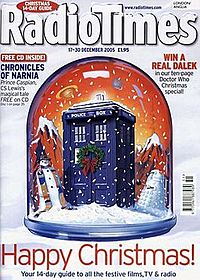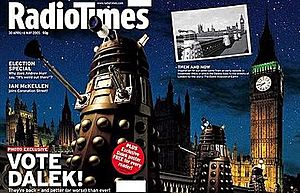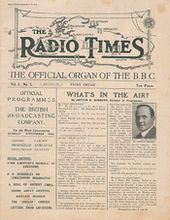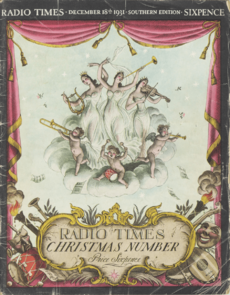Radio Times facts for kids

The 2005 Christmas double issue (dated 17–30 December) with cover illustration by Mark Thomas of Doctor Who's TARDIS in a snow globe
|
|
| Categories | TV and radio listings magazine |
|---|---|
| Frequency | Weekly |
| Circulation | 497,852 (July–December 2020) |
| First issue | 28 September 1923 |
| Company | George Newnes Ltd (1923–1937) BBC Magazines (1937–2011) Immediate Media Company (since 2011) |
| Country | United Kingdom |
| Based in | London, England |
| Language |
|
| ISSN | 0033-8060 |
Radio Times (also known as RadioTimes) is a popular British magazine published every week. It tells you what's on TV and radio. Besides listings, it also has cool interviews, movie reviews, and articles about different hobbies.
This magazine was started in May 1923 by John Reith, who was in charge of the British Broadcasting Company (which later became the BBC). It was the very first magazine in the world to list broadcast programmes!
For a long time, from 1937 to 2011, the BBC itself published the magazine. Then, it became part of a company called Immediate Media Company. In 2017, a German media group, Hubert Burda, bought Immediate Media.
The magazine comes out every Tuesday. It lists programmes for the week from Saturday to Friday. Since Christmas 1969, a special bigger issue is published in December. This issue covers two weeks of programmes, usually including Christmas and New Year's Day.
The Story of Radio Times
How it Started
The first Radio Times magazine came out on September 28, 1923. It cost just 2 old pennies! It listed programmes for six early BBC radio stations. Back then, newspapers didn't want to list radio programmes because they worried people would listen to the radio instead of reading their papers.
The magazine quickly became known for using famous writers and artists. Its special edition covers are now considered classic designs and are collected by many people. In 1927, an experimental Braille edition was even made for visually impaired readers. In 1933, a weekly crossword puzzle was added, which became very popular.
TV Listings Begin
In 1934, Radio Times started including a new section for the BBC's experimental television programmes. This made Radio Times the first-ever magazine to list TV shows! At first, only two pages were for TV, and it only broadcast from Monday to Saturday.
From 1937, the magazine officially dropped "The" from its name and became simply Radio Times. Before World War II, it had different versions for different parts of the UK, like London, Midlands, and Scotland.
During World War II
When Britain declared war in September 1939, TV broadcasting stopped. But radio listings continued throughout the war. Due to paper rationing, the magazines were much smaller, sometimes only 20 pages long with tiny print. TV broadcasting started again in June 1946.
Changes Over the Years
Over the decades, Radio Times changed its look and how it listed programmes many times.
- In 1953, TV listings moved to the front of the magazine, next to radio schedules.
- In 1960, the TV and radio schedules were put back together. A new, bold title was designed by Abram Games, a famous graphic designer.
- In 1967, the magazine introduced new colour pages for articles like gardening and cooking. Also, four new BBC radio stations were launched: BBC Radio 1, BBC Radio 2, BBC Radio 3, and BBC Radio 4.
- In 1969, the magazine got a big makeover. It stopped carrying cigarette ads and changed its date format. The lifestyle sections and crossword were removed for a while.
- In 1978, with new radio services for Scotland, Wales, and Northern Ireland, all BBC radio stations were put into a six-column grid.
- In the 1980s, the magazine faced some printing problems, causing some issues to be delayed or printed in a different format.
- In 1984, Radio Times started using new printing technology, making the magazine brighter and more colourful.
- In 1988, the Christmas issue sold an amazing 11.2 million copies! This made it the biggest-selling edition of any British magazine ever, a record listed in the Guinness World Records.
- In 1990, the entire magazine was printed in colour for the first time.
Opening Up to All Channels
A huge change happened on February 16, 1991. New rules meant Radio Times could now list programmes for all TV channels, not just the BBC! This included ITV, Channel 4, and even satellite channels. Before this, other magazines like TV Times listed ITV and Channel 4.
After this change, many new TV listing magazines appeared. Newspapers were also allowed to print full weekly TV schedules, which they couldn't do before.
Radio Times continued to update its layout to include all the new channels. By 1992, it had six pages of TV listings every day, covering movies, sports, news, and entertainment channels.
Modern Era Changes
- In 1993, VideoPlus+ number codes were added to help viewers record shows easily.
- In 1994, the TV listings were redesigned again, with the day's name written vertically.
- In 1999, the magazine's sections were rearranged, starting with letters, then film reviews, followed by the seven-day programme guide.
- In 2001, a new title design was introduced.
- In 2002, Radio Times partnered with NTL (a cable company) to offer a special edition to its customers.
- From 2004, the programme pages were revamped again to include more digital and cable channels like BBC3, BBC4, ITV2, and ITV3.
- In 2010, Radio Times had a big overhaul. The evening listings started earlier, and electronic program guide numbers were added.
- For the London 2012 Olympics, the listings were specially arranged to highlight the Olympic broadcasters.
- In 2020, to keep up with new ways of watching, Radio Times added sections for podcasts and streaming services like Disney+.
- In 2022, the magazine refreshed its format again, with expanded streaming pages and a new 'highlights' section. It also added more radio stations like Boom Radio and Greatest Hits Radio.
How Many Copies Are Sold?
In 1934, Radio Times sold two million copies. By the 1950s, it was the biggest-selling magazine in Europe, selling about 8.8 million copies in 1955!
Even after many years, Radio Times remained a top-selling magazine. In 2009, it sold around 1.6 million copies each week. By 2020, its weekly sales were about 497,852 copies.
Advertising the Magazine
After TV listings were opened up to all magazines in 1991, there was some debate. Other magazines complained that Radio Times was advertised on the BBC, saying it gave them an unfair advantage. The case went to court, and it was decided that Radio Times could be advertised by the BBC. However, from 1992 to 2004, the ads had to show a clear message: "Other television listings magazines are available."
Since 2005, Radio Times has not been promoted on BBC TV and radio channels to avoid complaints from rival publications.
Editors of the Magazine
Many people have been in charge of Radio Times over the years. Here are some of them:
- 1923–1926: Leonard Crocombe
- 1926–1927: Walter Fuller
- 1927–1933: Eric Maschwitz
- 1933–1941: Maurice Gorham
- 1941–1944: Gordon Stowell
- 1944–1954: Tom Henn
- 1954–1968: Douglas G. Williams
- 1968–1969: C. J. Campbell Nairne
- 1969–1979: Geoffrey Cannon
- 1979–1988: Brian Gearing
- 1988–1996: Nicholas Brett
- 1996–2000: Sue Robinson
- 2000–2001: Nicholas Brett (returned)
- 2001–April 2002: Nigel Horne
- April–July 2002: Liz Vercoe (uncredited)
- August 2002–August 2009: Gill Hudson
- September 2009 – 2017: Ben Preston
- 2017–2020: Mark Frith
- 2020–present: Tom Loxley and Shem Law
Famous Covers
Radio Times covers are very special. They often feature popular shows, actors, or big events.
- In 2005, 31 out of 51 issues had BBC-related covers.
- The magazine sometimes uses covers that open out, showing large group photos.
- For big sporting events like the Six Nations or Rugby World Cup, Radio Times often creates different covers for each country taking part.
- Major events like Remembrance Day, Eurovision Song Contest, or new series of popular shows also get special covers.
Royal Specials
Radio Times has published many special covers dedicated to the Royal Family. These often celebrate birthdays, coronations, jubilees, or royal weddings.
- In 1953, the magazine released a special 'Coronation Number' for Queen Elizabeth II, selling over 9 million copies!
- In 1977, to celebrate Queen Elizabeth II's Silver Jubilee, Radio Times and BBC1's Blue Peter held a competition for children to design a special cover. Over 65,000 children entered!
- In 2012, for Queen Elizabeth II's Diamond Jubilee, a new portrait painting by Peter Blake was featured on the cover.
- In 2022, for Queen Elizabeth II's Platinum Jubilee, an illustrator created a cover inspired by a classic 1937 coronation issue.
- When Queen Elizabeth II passed away in September 2022, Radio Times published a special tribute issue with a monochrome photograph and a black border.
Doctor Who Covers
Doctor Who is the show that has appeared on the Radio Times cover the most! It has been featured on 29 issues (with 35 different covers) since the show started in 1963.

- In 2005, a special double-width cover celebrated the return of the Daleks to Doctor Who and the upcoming general election. It showed Daleks crossing Westminster Bridge with the words "VOTE DALEK!". This cover was later voted the best British magazine cover of all time.
- For the show's 20th anniversary in 1983, an illustrated cover featured several actors who had played The Doctor.
- In 1993, for the 30th anniversary, surviving Doctors appeared to promote a special TV event.
- In 2013, to mark the 50th anniversary of Doctor Who, the magazine released a selection of 12 different covers!
Christmas Covers
The Christmas issue, often called the 'Christmas Number', usually has a festive artwork cover. These are different from the usual photographic covers. In recent years, Radio Times has even sold packs of these Christmas covers as Christmas cards.
Other Publications
Radio Times has also published other books and guides:
- An annual magazine was published in 1954, 1955, and 1956.
- The Radio Times Film & Video Guide was first published in 1994, listing over 18,000 films. The last edition of the Radio Times Guide to Films was in 2018.
- There are also guides like the Radio Times Guide to TV Comedy and the Radio Times Guide to Science-Fiction.
Regional Editions
Radio Times has different editions for different parts of the UK. This is because TV and radio programmes can vary by region.
- From 2023, the regional editions in England were combined into one. This edition includes times for all BBC local radio stations and notes about regional TV variations.
- There are also separate editions for Scotland, Wales, and Northern Ireland. These editions include listings for their specific local BBC and ITV channels, as well as other local services like S4C in Wales or RTÉ channels in Northern Ireland.
Over the years, the number of regional editions has changed. They have gradually been reduced as there are fewer differences in programme schedules across regions. For example, the North of England region was separated from Northern Ireland in 1948. Later, regions like Midlands and East Anglia were merged.
Online and Digital
Website
The Radio Times website was launched in June 1997. It started as a basic listings service but has grown to offer many articles and recommendations for TV, radio, and films.
Digitising the Past
In 2012, the BBC finished a huge project called the BBC Genome Project. They scanned all the programme listings from about 4,500 copies of Radio Times from 1923 to 2009. This created a massive online database of BBC programmes. They found around five million programmes and 8.5 million people involved in making them!
The results were made public in 2014. People can even help correct any errors in the scanned text. Digitised versions of the entire magazines, including covers, articles, and old advertisements, have been added online for the 1920s, 1930s, 1940s, and 1950s.
Puzzles and Podcasts
- In 2020, Radio Times launched an online puzzle site. It uses brainteasers based on popular TV and radio shows like Eggheads and Countdown.
- In 2021, Radio Times started a podcast show. It features interviews with TV celebrities and discusses what's on screen.
More About Radio Times
- Most Powerful People – a list published yearly from 2003 to 2005, showing important people in British TV and radio.
- Radio Times Extra – a digital guide that provides full TV listings for 14 days.
- Radio Times's TV 100 - another annual list, focusing on TV talents.



